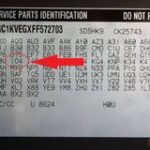OBD2 freeze frame data is a valuable tool for diagnosing car problems. It provides a snapshot of your vehicle’s sensor readings at the exact moment a fault code was triggered. Understanding this data can help pinpoint the root cause of malfunctions and facilitate faster repairs. This guide will delve into what OBD2 freeze frame data is, how to access it, and answer frequently asked questions.
Understanding OBD2 Freeze Frame Data
Freeze frame data, essentially a snapshot of your car’s internal conditions, is captured by the Engine Control Unit (ECU) when a diagnostic trouble code (DTC) is set. This snapshot records various sensor readings at the precise moment the fault occurred. Think of it as a “black box” recording for your car’s engine. This data is invaluable because it provides context to the DTC, allowing mechanics to understand the circumstances surrounding the fault, rather than just knowing a code was triggered. The data includes critical parameters such as:
- Engine Speed (RPM): How fast the engine was rotating.
- Vehicle Speed: How fast the car was traveling.
- Coolant Temperature: The engine’s operating temperature.
- Calculated Load Value: How much strain the engine was under.
- Fuel System Status: Information about the fuel delivery system.
- Short and Long Term Fuel Trim: Adjustments made to fuel delivery to maintain optimal combustion.
- Intake Air Temperature: The temperature of the air entering the engine.
- Mass Air Flow (MAF) Sensor Reading: The amount of air entering the engine.
- Oxygen Sensor Readings: Data from the oxygen sensors used to monitor emissions.
This comprehensive data set allows mechanics to reconstruct the operating conditions when the fault occurred, leading to a more accurate diagnosis. For example, a P0301 code (Cylinder 1 Misfire) alongside freeze frame data showing low fuel pressure suggests a fuel delivery issue might be contributing to the misfire, rather than a faulty spark plug.
Accessing Freeze Frame Data
Accessing freeze frame data requires an OBD2 scanner. Most scanners available today can retrieve and display this information. Connect the scanner to your vehicle’s OBD2 port, typically located under the dashboard on the driver’s side. The scanner will communicate with the ECU and retrieve any stored DTCs and their associated freeze frame data. Many scanners present the data in a user-friendly format, clearly labeling each parameter and its value. Software like OBD Auto Doctor can further enhance readability and provide detailed explanations of the data.
It’s crucial to access freeze frame data as soon as possible after the Check Engine Light illuminates. Some vehicles only store one freeze frame snapshot per DTC. Subsequent faults can overwrite previous data, leading to the loss of valuable diagnostic information.
Frequently Asked Questions
Can a vehicle store multiple freeze frames?
Yes, some manufacturers allow for the storage of multiple freeze frames, recording data for different DTCs or instances of the same fault. The number of stored frames and the conditions for capturing them are vehicle-specific.
Can there be a DTC without freeze frame data?
While uncommon, it’s possible for a DTC to be set without accompanying freeze frame data. This might occur due to specific vehicle configurations or if the fault doesn’t trigger the freeze frame recording criteria.
Can freeze frame data exist without a Check Engine Light?
Yes, in certain situations, a vehicle might clear the Check Engine Light after multiple successful driving cycles without the fault recurring. However, the freeze frame data related to the original fault might remain stored in the ECU, providing evidence of an intermittent problem.
Can freeze frame data be reset?
Yes, clearing DTCs with an OBD2 scanner usually erases associated freeze frame data. This action resets the diagnostic system, but the data will be captured again if the fault reoccurs. Using OBD Auto Doctor simplifies this process.
Conclusion
OBD2 freeze frame data provides crucial context for understanding and diagnosing car problems. This “snapshot in time” allows mechanics to see the vehicle’s operating conditions when a fault occurred, facilitating more efficient troubleshooting and repairs. Understanding what freeze frame data is and how to access it empowers car owners to be more informed when dealing with vehicle issues.

